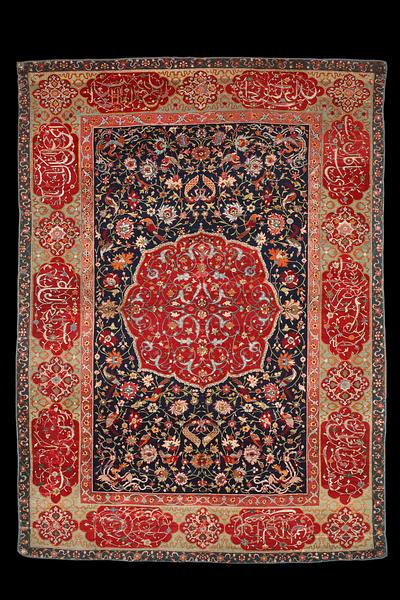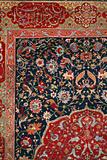“Salting carpet,” wool, silk, and metal lamella
Iran; c. 1600
H: 226; W: 162 cm
Around an octagonal central medallion with arabesques is a rectangular panel with phoenixes and other exotic birds among tendrils with Chinese-inspired flowers. The widest of the three surrounding borders has ten panels with Persian verses written in Nastaliq – some of them mirror images. The palette is quite varied and was supplemented with silver lamella.
The carpet, whose decoration clearly reflects the Safavid court style in around 1600, belongs to a group that for a time was believed to comprise 19th-century Turkish copies of older Persian originals. This theory has now been disproved on the basis of historic, stylistic, and especially technological arguments.
Inv. no. 3/1964
Published in:
American Art Association, New York, 23/4-1932, lot 16;
Arthur Upham Pope and Phyllis Ackerman (eds.): A survey of Persian art: from prehistoric times to the present, London 1938-39, pl. 1161;
C.L. Davids Samling. Fjerde Del : Jubilæumsskrift 1945-70, København 1970, cat.no. 4, pp. 248 and 252;
Kjeld von Folsach: Davids Samling gennem 24 år, 1962-1985 = The David Collection: a 24-year period: 1962-1985, København 1985, pp. 72-73;
Kjeld von Folsach: Islamic art. The David Collection, Copenhagen 1990, cat.no. 421;
John Mills: “The Salting group: a history and a clarification” in Murray L. Eiland and Robert Pinners (eds.): Oriental carpet and textile studies, 5:2: The Salting carpets, Danville 1999, pp. 3 and 12-13, no. 4, fig. 11;
Kjeld von Folsach: Art from the World of Islam in The David Collection, Copenhagen 2001, cat.no. 689;
Jonathan M. Bloom: “From memory to drawing: The evolution of Islamic design”, in Sheila S. Blair, Jonathan M. Bloom, Sandra S. Williams (eds.): Iranian art from the Sasanians to the Islamic Republic: essays in honour of Linda Komaroff, Edinburgh 2024, pp. 29-49;


